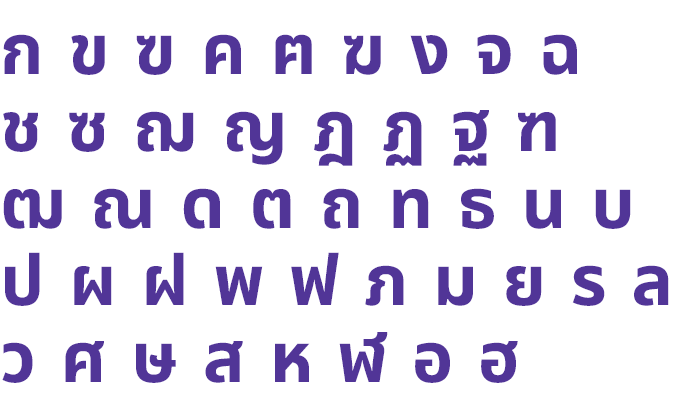Thailand is a land of ancient civilizations with unique and outstanding features in the spoken and written forms of its language. It is one of the countries that has its own language. The Thai language is the official language of the country, which has been used for quite a long time, hundreds of years. However, the characteristics of the spoken language are different in each region, though the written form is standardized.
There are 44 Thai consonants but only 42 consonants are used these days. The two consonants that have not been used since 2002 are ฃ and ฅ (Department of Academic Affairs, 2002:69). Thai has 44 consonants and 21 distinct consonant sounds, as follows:
Many of the letters resemble one another, the differences being in the “head,” the small circle where the letter begins, and other shapes that distinguish them from their “family members.” Once these basic shapes and attachments are learned, it’s not hard to distinguish the letters.
The Thai language is split into different dialects, namely the central Thai dialect, southern Thai dialect, northeastern Thai dialect, and northern Thai dialect or Lanna language (Kam Mueang). Besides these, in some small communities, there are languages used within their groups, such as Thai Chinese people who speak Chinese, Muslim people in the lower southern region speaking Melayu, and hill tribe people who speak their own languages, but they use the same alphabet and written language across the country.
Due to the rapidly changing times today, new Thai words are created to be more easily spoken and written, becoming slang popularly spoken among teenagers, such as “ai tao,” which is used to begin a sentence that expresses adoration, or to add softness and cuteness to the noun or adjective that usually comes after. “Pang mak” is used to describe anything as excellent, majestic, stunning, popular, and so on. In Thailand, foreign languages are often used in daily communication, such as English, Chinese, or Japanese among people working with foreigners, such as people working in the government sector, in the fields of education, tourism, or commerce, and those who graduated from overseas. Moreover, there are some local languages and other language varieties.
